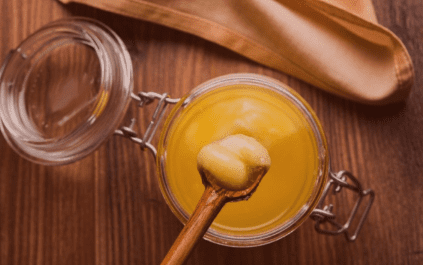What’s The Difference Between Regular Butter, Ghee, And Clarified Butter? Butter is present in every kitchen in the world. It is part of our daily lives from the moment we wake up to the day’s last meal.
Do you think you can live without it?
Imagine a French bread, muffin, or croissant coming out of the oven. You will want to butter the bread and muffin, while the croissant, which you will also be tempted to do the same, is a dough rolled in butter.
If your diet doesn’t allow butter consumption, get ready to know that it is present in many recipes, including that medium or rare steak served with a mouth-watering shine.
That shine is nothing more than melted butter flavored with garlic, thyme, or rosemary, to become “butter basted-steak.”
Sautéing vegetables or seafood, frying eggs, preparing omelets, rice, stir-fries, roast meats, or flavored bread are all made with butter.
However, some recipes call for regular butter, clarified butter, or ghee in Indian recipes.
Do you know the difference between each other?
Without butter, there’s no reason to come to France.
Paul Bocuse – French chef
Jump To Section
- What is Regular Butter?
- What Is Ghee, And What Is Its Origin?
- What Is The Role Of Clarified Butter in Culinary?
What Is Regular Butter?

Butter is a product obtained from whipped cream until the fat molecules agglomerate, becoming an emulsion. In its composition, we find:
- Milk fat: 82 %
- Water (whey): 16 %
- Milk solids (casein): 2 %
Salt is optionally added to the butter to improve the taste and help conservation.
Generally, its use in cooking is in preparing pasta, pies, and sweets, and for finishing sauces, as thickeners and giving a bright color, as well as in meats to add flavor and shine.
What Is Ghee, And What Is Its Origin?

Ghee is butter that has been clarified to remove milk solids and water, leaving a composition of around 99-100% pure fat.
Ghee is a type of clarified butter. Very popular in Indian cuisine, it was developed to extend the shelf life of butter and can last up to six months, while regular butter lasts about three weeks after opening.
It is also an ingredient of the traditional medicine of the Indian region known as Ayurveda.
The preparation of ghee involves the first steps of clarified butter. However, instead of removing the butter from the heat when the milk solids separate, usually let it cooks longer.
In culinary, ghee can be used as ordinary butter or cooking oil to prepare stews, vegetables, and meats, besides Indian recipes.
Its main advantage in cooking is that ghee has a higher “smoke point” than regular butter, which will not burn when cooking over high heat.
It can also be a butter substitute for lactose intolerant people because lactose and casein are removed with the milk solids of butter.
What Is The Role Of Clarified Butter in Culinary?
Clarified butter removes its water and milk proteins, leaving a 99-100% pure butterfat composition.
It has a higher “smoke point” than regular butter, which won’t burn when cooking over high heat, like ghee.
Clarified butter can be heated to a maximum of 450°F / 232°C, while regular butter can be heated to around 350°F / 175°C.
Therefore, it is ideal for sautéing vegetables, seafood, meat, or pasta, as it requires high heat for this purpose, giving the food a nutty flavor and velvety and creamy texture.
It has a longer shelf life than regular butter and can be stored at room temperature for a few weeks, six months in the fridge, or years when frozen.
To prepare the clarified butter, proceed as follows:
- Melt the butter over low heat in a pan.
- The butter will foam as the water starts to evaporate.
- White particles of milk solids will form and begin to accumulate at the bottom of the pan.
- At this point, you can pass the contents through a fine sieve or Chinoy lined with cheesecloth to a recipient or collect the clarified butter using a ladle or spoon, discarding the water and solids from the top and bottom of the pan.
The milk solids in butter are primarily responsible for burning butter and food when cooking over high heat. Once removed, the only fat remaining is clarified butter with a high smoke point.
Generally, 454g of regular butter yields approximately 340g of clarified butter.
Like ghee, clarified butter is versatile in the kitchen for preparing french toast, sautéeing meat or vegetables, mixing in popcorn, making omelets, etc.
It is also ideal for recipes that require a considerable amount of butterfat, like Hollandaise sauce.
Bottom Line
Butter is present in many pastry and savory recipes worldwide.
When clarifying the butter and removing the milk solids, only the precious golden fat of the butter remains, which can be used to fry and sauté foods and make sauces, such as hollandaise.
Clarified butter and ghee have a longer shelf life than regular butter. In addition, it adds a nutty flavor and a creamy, velvety texture to foods.
Did you make this recipe?
I hope this article has enriched your knowledge of cooking. To learn more take a look at What Is Roux? Learn How To Make The Basic Ingredient Of French Cuisine
Please let me know how it turned out for you! Leave a comment below and share our content.
Help our community grow by following our social media on Spotify, Instagram, Facebook, Youtube, and Tiktok, and stay up to date with the news from the world of Gastronomy.
Don’t forget to tag @gastrovinoacademy on Instagram and hashtag it #gastrovinoacademy.
Cheers🍷


